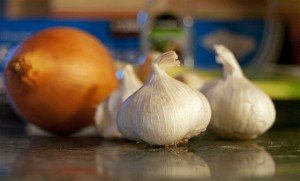 The health benefits of garlic have been well researched in the scientific literature. The historical use of garlic has also been reviewed1. Although it is unclear as to the origins of the use of garlic as a medicinal herb, garlic was known to the ancient Egyptians. Garlic was probably consumed daily by Egyptians, and garlic bulbs were identified from the Tomb of King Tutankhamen which is thought to date back to around 1500 BC. The Codex Ebers was an Egyptian medical text that mentions garlic being used medicinally as a treatment for abdominal growths, circulatory ailments, general malaise and insect and parasite infestations. Biblical references to slaves in Egypt being given garlic is further evidence of ancient medicinal knowledge of garlic. It would seem very unlikely that the Sumerians were not aware of the benefits of garlic.
The health benefits of garlic have been well researched in the scientific literature. The historical use of garlic has also been reviewed1. Although it is unclear as to the origins of the use of garlic as a medicinal herb, garlic was known to the ancient Egyptians. Garlic was probably consumed daily by Egyptians, and garlic bulbs were identified from the Tomb of King Tutankhamen which is thought to date back to around 1500 BC. The Codex Ebers was an Egyptian medical text that mentions garlic being used medicinally as a treatment for abdominal growths, circulatory ailments, general malaise and insect and parasite infestations. Biblical references to slaves in Egypt being given garlic is further evidence of ancient medicinal knowledge of garlic. It would seem very unlikely that the Sumerians were not aware of the benefits of garlic.
It is also known that garlic was used in ancient Greece, and can be dated back to around 1500 BC at the palace of Knossos in Crete. Hippocrates used garlic as part of his medicinal therapies and it is historically recorded that he recommended garlic for pulmonary complaints, as a purgative agent as well as for abdominal and uterine growths. Garlic may have been one of the earliest athletic ergogenic aids as some evidence suggests that it was used in the earliest Olympic games. In similar fashion, the Romans fed garlic to soldiers and sailors because of its perceived ability to increase strength and stamina. Dioscorides was a Greek physician serving with Nero’s army and he recommended garlic because of its benefits to the blood. Pliny the Elder was another Greek physician who recommended garlic in his five-volume Historica Naturis.
In Asia, garlic’s use can be traced back in ancient China to roughly 2000 BC. Garlic was a staple food of the ancient Chinese and was possibly used as a food preservative. Garlic is widely used in modern Chinese medicine where it has been traditionally used to treat respiratory problems, headache, insomnia, diarrhoea and worm infestations as well as mental disorders such as sadness and depression. The Chinese were aware of garlic’s ability to prevent fatigue, and it was also used to treat male impotency. Ayuvedic medicine in India also was aware of the healing properties of garlic and used it widely. The use of garlic is recorded in the 2000 year old Charaka-Samhits where it is recommended for cardiovascular problems and arthritis. Ancient Indian medicine also recognised the blood pressure lowering effect attained form garlic consumption.
In Europe, garlic use was probably spread by the Roman Empire to its conquered lands. Following the fall of the Roman empire, garlic was known to be used by monks in medieval times in monasteries in roughly 800 AD. Garlic was believed to be able to relieve constipation when made into a drink, and was fed to workers to relieve heat stroke. Garlic’s use is recorded in the medical school in Salerno, where it was recommended in the winter to relieve breathing and pulmonary disorders. During the 16th Century garlic was widely used during the Renaissance. Pietro Mattiola of Siena prescribed garlic for digestive disorders, infestations with worms, with renal disorders as well as to help women during difficult childbirth. In medieval England garlic was used for toothache, constipation, dropsy, animal bites and the plague.
There is a theme with the ancient use of garlic in the historical record. It was used to provide strength and vitality, it was thought to be beneficial to the cardiovascular system, and it was used as an infection fighter. It uses by workers, soldiers and sailors to fight fatigue, may relate to the relate to the present of saponins within the garlic that have been shown in animal models to raise testosterone levels. Garlic’s benefits to the cardiovascular system have been investigated thoroughly by modern science and garlic is known to be able to lower cholesterol levels, provide antioxidant defence, as well as lower blood pressure. These effects may be due to the presence of sulphur compounds within chopped garlic. These same chemicals are know to possess antifungal, antibacterial and anti parasitic properties which supports the ancient use of garlic as a preservative, and infection fighting agent.
RdB
